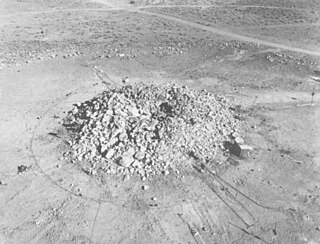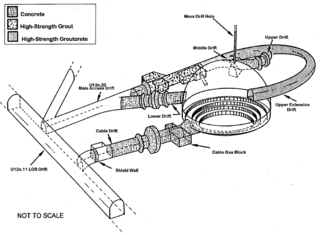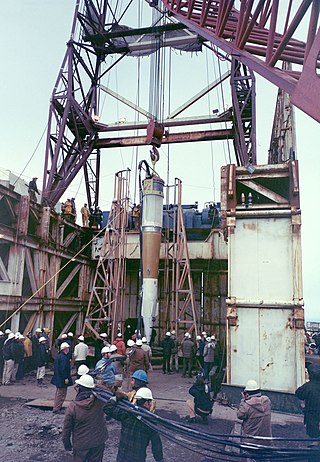
The Nevada National Security Site, known as the Nevada Test Site (NTS) until 2010, is a United States Department of Energy (DOE) reservation located in southeastern Nye County, Nevada, about 65 miles (105 km) northwest of the city of Las Vegas. Formerly known as the Nevada Proving Grounds, the site was established in 1951 for the testing of nuclear devices. It covers approximately 1,360 square miles (3,500 km2) of desert and mountainous terrain. Nuclear weapons testing at the site began with a 1-kiloton (4.2 TJ) bomb dropped on Frenchman Flat on January 27, 1951. Over the subsequent four decades, over 1,000 nuclear explosions were detonated at the site. Many of the iconic images of the nuclear era come from the site.

The United States's Whetstone nuclear test series was a group of 46 nuclear tests conducted in 1964–1965. These tests followed the Operation Niblick series and preceded the Operation Flintlock series.
Operation Latchkey was a series of 38 nuclear tests conducted by the United States in 1966–1967 at the Nevada Test Site. These tests followed the Operation Flintlock series and preceded the Operation Crosstie series.

The United States's Bowline nuclear test series was a group of 47 nuclear tests conducted in 1968–1969. These tests followed the Operation Crosstie series and preceded the Operation Mandrel series.

The United States's Mandrel nuclear test series was a group of 52 nuclear tests conducted in 1969–1970. These tests followed the Operation Bowline series and preceded the Operation Emery series.

The United States's Emery nuclear test series was a group of 16 nuclear weapons tests conducted in 1970 and 1971. These tests followed the Operation Mandrel series and preceded the Operation Grommet series.
Operation Quicksilver was a series of 16 nuclear tests conducted by the United States in 1978–1979 at the Nevada Test Site. These tests followed the Operation Cresset series and preceded the Operation Tinderbox series.

Operation Teapot was a series of 14 nuclear test explosions conducted at the Nevada Test Site in the first half of 1955. It was preceded by Operation Castle, and followed by Operation Wigwam. Wigwam was, administratively, a part of Teapot, but it is usually treated as a class of its own. The aims of the operation were to establish military tactics for ground forces on a nuclear battlefield and to improve the nuclear weapons used for strategic delivery.

Operation Sunbeam was a series of four nuclear tests conducted at the United States's Nevada Test Site in 1962. Operation Sunbeam tested tactical nuclear warheads; the most notable was the Davy Crockett.
The United States's Praetorian nuclear test series was a group of 19 nuclear tests conducted in 1981–1982. These tests followed the Operation Guardian series and preceded the Operation Phalanx series.
Operation Fusileer was a series of 16 nuclear tests conducted by the United States in 1983–1984 at the Nevada Test Site. These tests followed the Operation Phalanx series and preceded the Operation Grenadier series.

Operation Charioteer was a series of 16 nuclear tests conducted by the United States in 1985–1986 at the Nevada Test Site. These tests followed the Operation Grenadier series and preceded the Operation Musketeer series.
The United States's Cornerstone nuclear test series was a group of 11 nuclear tests conducted in 1988–1989. These tests followed the Operation Touchstone series and preceded the Operation Aqueduct series.

The United States's Grommet nuclear test series was a group of 34 nuclear tests conducted in 1971–1972. These tests followed the Operation Emery series and preceded the Operation Toggle series.
The United States's Arbor nuclear test series was a group of 18 nuclear tests conducted in 1973–1974. These tests followed the Operation Toggle series and preceded the Operation Bedrock series.
The United States's Fulcrum nuclear test series was a group of 21 nuclear tests conducted in 1976–1977. These tests followed the Operation Anvil series and preceded the Operation Cresset series.
The United States's Cresset nuclear test series was a group of 22 nuclear tests conducted in 1977–1978. These tests followed the Operation Fulcrum series and preceded the Operation Quicksilver series.

Operation Anvil was a series of 21 nuclear tests conducted by the United States in 1975–1976 at the Nevada Test Site. These tests followed the Operation Bedrock series and preceded the Operation Fulcrum series.
Operation Roller Coaster was a series of four nuclear tests conducted jointly by the United States and the United Kingdom in 1963, at the Nevada Test Site. The tests did not involve the detonation of any nuclear weapons. Instead, their purpose was to evaluate the distribution of radioactive particles in a "dirty bomb" scenario, or an inadvertent, non-nuclear detonation of a nuclear weapon, as well as to evaluate the effectiveness of storage structures in containing the explosion and the particles released. The tests followed the Operation Storax series and preceded the Operation Niblick series.
Operation Project 56 was a series of 4 nuclear tests conducted by the United States in 1955–1956 at the Nevada Test Site. These tests followed the Operation Wigwam series and preceded the Operation Redwing series.











